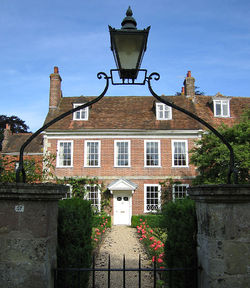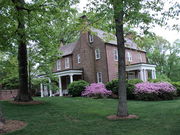Georgian architecture

Georgian architecture is the name given in most English-speaking countries to the set of architectural styles current between 1720 and 1840. It is eponymous for the first four British monarchs of the House of Hanover—George I of Great Britain, George II of Great Britain, George III of the United Kingdom, and George IV of the United Kingdom—who reigned in continuous succession from August 1714 to June 1830.
Contents |
History and definition

Georgian succeeded the English Baroque of Sir Christopher Wren, Sir John Vanbrugh, Thomas Archer, William Talman and Nicholas Hawksmoor. The architect James Gibbs was a transitional figure many of his buildings having a hint of Baroque, reflecting the time he spent in Rome in the early 18th century. Major architects to promote the change in direction from baroque were Colen Campbell, author of the influential book Vitruvius Britannicus; Richard Boyle, 3rd Earl of Burlington and his protegé William Kent; Isaac Ware; Henry Flitcroft and the Venetian Giacomo Leoni, who spent most of his career in England. Other prominent architects of the early Georgian period include James Paine, Robert Taylor & John Wood, the Elder.
The styles that resulted fall within several categories. In the mainstream of Georgian style were both Palladian architecture— and its whimsical alternatives, Gothic and Chinoiserie, which were the English-speaking world's equivalent of European Rococo. From the mid-1760s a range of Neoclassical modes were fashionable, associated with the British architects Robert Adam, James Gibbs, Sir William Chambers, James Wyatt, George Dance the Younger, Henry Holland and Sir John Soane. John Nash was one of the most prolific architects of the late Georgian era known as The Regency style, he was responsible for designing large areas of London. Greek Revival was added to the design repertory the main exponents being William Wilkins and Robert Smirke, their work dominates late Georgian architecture is characterized by its proportion and balance; simple mathematical ratios were used to determine the height of a window in relation to its width or the shape of a room as a double cube. "Regular" was a term of approval, implying symmetry and adherence to classical rules: the lack of symmetry, where Georgian additions were added to earlier structures, was deeply felt as a flaw. Regularity of housefronts along a street was a desirable feature of Georgian town planning. Georgian designs usually lay within the Classical orders of architecture and employed a decorative vocabulary derived from ancient Rome or Greece. The most common building materials used are brick or stone. Commonly used colors were red, tan, or white. However, modern day Georgian style homes use a variety of colors.
General characteristics
Identifying Features (1700 – c.1780):
- A simple 1–2 story box, 2 rooms deep, using strict symmetry arrangements
- Panel front door centered, topped with rectangular windows (in door or as a transom) and capped with an elaborate crown/entablature supported by decorative pilasters
- Cornice embellished with decorative moldings, usually dentilwork
- Multi-pane windows are never paired, and fenestrations are arranged symmetrically (whether vertical or horizontal), usually 5 across
Other features of Georgian style houses can include – roof to ground-level:
- Roof: 40% are Side-gabled; 25% Gambrel; 25% Hipped
- Chimneys on both sides of the home
- A portico in the middle of the roof with a window in the middle is more common with post-Georgian styles, e.g. "Adam"
- Small 6-paned sash windows and/or dormer windows in the upper floors, primarily used for servant's quarters. This was also a way of reducing window tax.
- Larger windows with 9 or 12 panes on the main floors
Colonial Georgian architecture
.jpg)


Georgian Architecture was widely disseminated in the English colonies of the time. In the American colonies, colonial Georgian blended with the neo-Palladian style to become known more broadly as 'Federal style architecture'. Georgian buildings were also constructed of wood with clapboards; even columns were made of timber, framed up and turned on an over-sized lathe. Brown University and the College of William and Mary in Williamsburg, Virginia, offer leading examples of Georgian architecture in the Americas.
Unlike the Baroque style that it replaced, which was generated almost solely in the context of palaces and churches, Georgian had wide currency in the upper and middle classes. Within the residential context, the best remaining example is the pristine Hammond-Harwood House (1774) in Annapolis, Maryland. This house was designed by colonial architect William Buckland and modeled on the Villa Pisani at Montagnana, Italy as depicted in Andrea Palladio's I Quattro Libri dell'Architettura (Four Books Of Architecture).
The establishment of Georgian architecture, and the Georgian styles of design more generally, were to a large degree aided by the fact that, unlike earlier styles which were primarily disseminated among craftsmen through the direct experience of the apprenticeship system, Georgian was also spread through the new medium of inexpensive suites of engravings. From the mid-18th century, Georgian styles were assimilated into an architectural vernacular that became part and parcel of the training of every architect, designer, builder, carpenter, mason and plasterer, from Edinburgh to Maryland.
Post-Georgian developments
After about 1840 Georgian conventions were slowly abandoned as a number of revival styles, including Gothic Revival, enlarged the design repertoire. In the United States this style declined in popularity after the revolution, due to its association with the colonial regime; but later in the early decades of the twentieth century when there was a growing nostalgia for its sense of order, the style was revived and came to be known as the Colonial Revival. In Canada the United Empire Loyalists embraced Georgian architecture as a sign of their fealty to Britain, and the Georgian style was dominant in the country for most of the first half of the 19th century. The Grange, for example, a manor built in Toronto, was built in 1817.
The revived Georgian style that emerged in Britain at the beginning of the 20th century is usually referred to as Neo-Georgian; the work of Edwin Lutyens includes many examples. Versions of the Neo-Georgian style were commonly used in Britain for certain types of urban architecture until the late 1950s, Bradshaw Gass & Hope's Police Head Quarters in Salford of 1958 being a good example. In both the United States and Britain, the Georgian style is still employed by architects like Quinlan Terry for private residences.
See also
- Golden ratio
- Townhouse
- Jamaican Georgian architecture
- Georgian Dublin
Further reading
- McAlester, Virginia & Lee, A Field Guide To American Houses 1996 ISBN 0-394-73969-8
- Howard Colvin, A Biographical Dictionary of British Architects, 3rd ed. 1995.
- John Cornforth, Early Georgian Interiors, (Paul Mellon Centre) 2005.
- James Stevens Curl, Georgian Architecture.
- Christopher Hussey, Early Georgian Houses,, Mid-Georgian Houses,, Late Georgian House,. Reissued in paperback, Antique Collectors Club, 1986.
- Frank Jenkins, Architect and Patron 1961.
- Barrington Kaye, The Development of the Architectural Profession in Britain 1960.
- Sir John Summerson, Georgian London, (1945). Revised edition, edited by Howard Colvin, 2003.
- Sir John Summerson, Architecture in Britain (series: Pelican History of Art) Reissued in paperback 1970
External links
 Media related to Georgian architecture at Wikimedia Commons
Media related to Georgian architecture at Wikimedia Commons
 Media related to Georgian homes in Sydney at Wikimedia Commons
Media related to Georgian homes in Sydney at Wikimedia Commons- Georgian Terrace in Horsham
|
|||||||||||||||||||||||||||||||||||